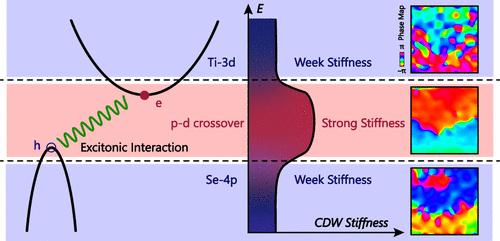单层 1T-TiSe2 中由 P-d 相关性决定的电荷阶刚度和相应的量子熔化
IF 16
1区 材料科学
Q1 CHEMISTRY, MULTIDISCIPLINARY
引用次数: 0
摘要
1T-TiSe2 是备受追捧的激子绝缘体的有望候选者,它具有神秘的电荷密度波(CDW)阶,由于电子和晶格自由度之间的鸡生蛋、蛋生鸡的纠缠关系,其微观起源难以确定。它的电荷密度波(CDW)经历了有趣但难以捉摸的量子熔化,并最终在金属插层作用下进入超导阶段,这表明熔化阶波动可能在粘合电子配位方面发挥了作用。利用光谱成像扫描隧道显微镜(STM),我们从空间和能带两个维度观察了单层 1T-TiSe2 的 CDW 熔化过程,从而获得了纯电子行为。在实际空间中,原生晶格缺陷会扰乱局部有序参数并刺激 CDW 熔化。在能带空间中,不同状态对熔化刺激表现出不同的刚度,从而产生独特的熔化纹理。量子熔化过程中 CDW 拓扑缺陷和结构因子的演变为评估 CDW 相干性提供了一个直接的途径,这表明 CDW 的硬度与 p-d 库仑相关性的强度成比例。我们的研究揭示了具有带-轨道-相关性变化特征的 CDW 量子熔化,并令人信服地强调了激子相互作用在稳定单层 TiSe2 电荷秩序中不可或缺的作用。本文章由计算机程序翻译,如有差异,请以英文原文为准。

P-d Correlation-Determined Charge Order Stiffness and Corresponding Quantum Melting in Monolayer 1T-TiSe2
1T-TiSe2, a promising candidate of the sought-after excitonic insulator, possesses an enigmatic charge density wave (CDW) order of which the microscopic origin is formidable to settle owing to the chicken-and-egg entanglement between the electron and lattice degrees of freedom. Its CDW experiences an intriguing but elusive quantum melting and eventually enters the superconducting phase under metal intercalation, suggesting the possible role of melted-order fluctuation in gluing the electron paring. Employing the spectroscopic imaging scanning tunneling microscope (STM), we access the pure electronic behavior by visualizing the CDW melting process of monolayer 1T-TiSe2 in both the space and energy-band dimensions. In real space, the native lattice imperfections disturb the local order parameter and stimulate the melting of CDW. In energy-band space, different states exhibit varying stiffness against the melting stimuli, yielding distinctive melted textures. The evolution of CDW topological defects and the structure factor in the quantum melting process provide a straightforward avenue to evaluate the CDW coherency, which shows that the CDW stiffness scales with the strength of the p-d Coulomb correlation. Our study reveals the quantum melting of CDW with an altering band-orbital-correlation character and puts compelling emphasis on the indispensable role of excitonic interaction in stabilizing the charge order of monolayer TiSe2.
求助全文
通过发布文献求助,成功后即可免费获取论文全文。
去求助
来源期刊

ACS Nano
工程技术-材料科学:综合
CiteScore
26.00
自引率
4.10%
发文量
1627
审稿时长
1.7 months
期刊介绍:
ACS Nano, published monthly, serves as an international forum for comprehensive articles on nanoscience and nanotechnology research at the intersections of chemistry, biology, materials science, physics, and engineering. The journal fosters communication among scientists in these communities, facilitating collaboration, new research opportunities, and advancements through discoveries. ACS Nano covers synthesis, assembly, characterization, theory, and simulation of nanostructures, nanobiotechnology, nanofabrication, methods and tools for nanoscience and nanotechnology, and self- and directed-assembly. Alongside original research articles, it offers thorough reviews, perspectives on cutting-edge research, and discussions envisioning the future of nanoscience and nanotechnology.
 求助内容:
求助内容: 应助结果提醒方式:
应助结果提醒方式:


